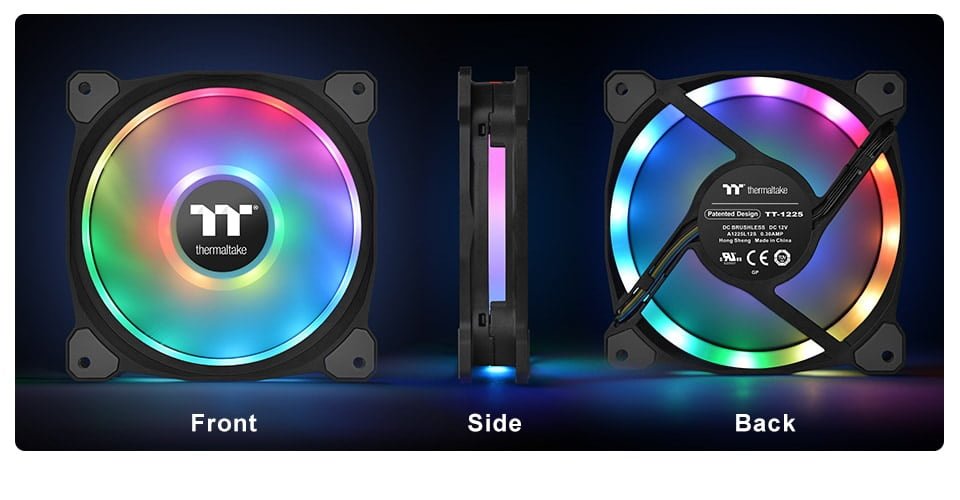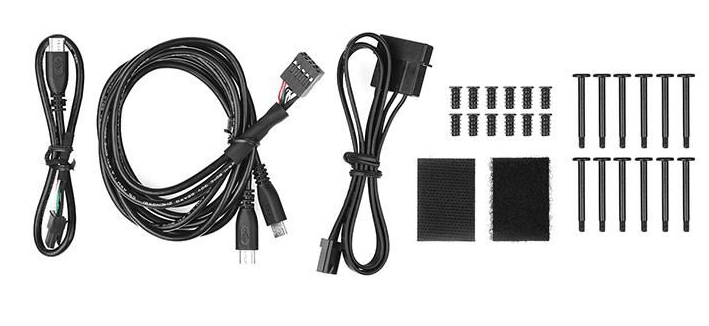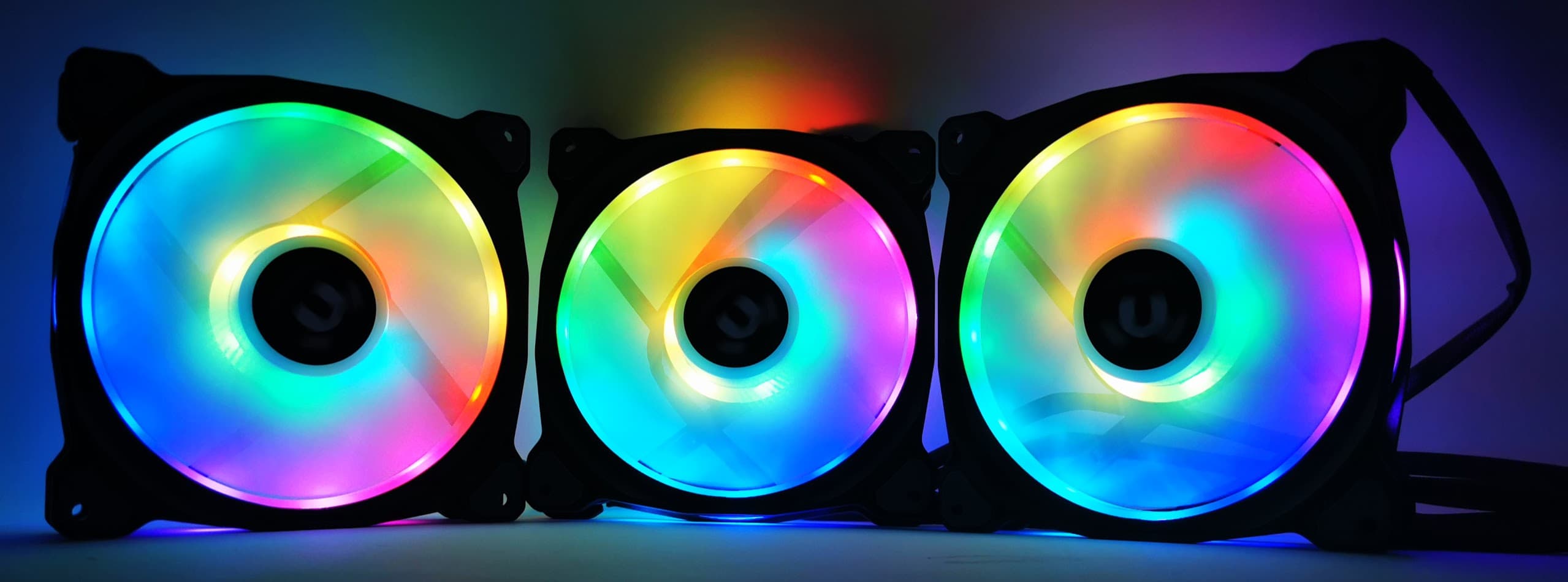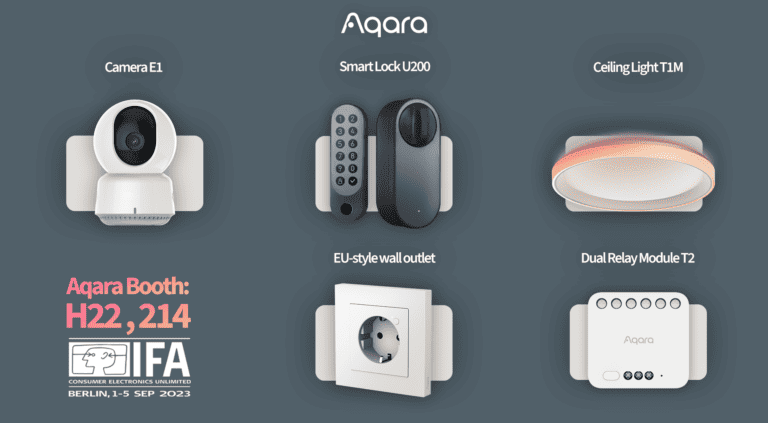Any links to online stores should be assumed to be affiliates. The company or PR agency provides all or most review samples. They have no control over my content, and I provide my honest opinion.
If you like RGB, it is safe to say Thermaltake has a product to suit your needs.
Their range of fans is an excellent example of this, looking on Amazon there are six different 120mm three packs, and five 140mm three packs, plus five packs and single fans. They all do more or less the same thing, but each one differs to suit particular needs and at different price points.
Previously I have already reviewed the Riing Trio 12 120mm fan pack, the then 140mm Pure 14 ARGB Sync fan pack. Today I have the Riing Duo 140mm RGB fan pack.
[content-egg module=Amazon template=list]
Thermaltake does three types of fans; standard static LED fans for the budget-conscious. Then motherboard sync and control fans which are mostly ARGB and come with a four-pin PWM header then an additional 5V RGB cable. Lastly, there are the hub/TT RGB software control fans. These fans use a USB type header that is then plugged into a hub and this is all controlled via your PC.
One of the significant benefits of the hub style of fan is that there are no motherboard requirements for the RGB control. I have found that a lot of mid or lower-priced motherboards lack the 5V RGB headers, so don’t work with the ARGB Sync fans (though manual switching still works).
On the flip side of this, the ARGB fans can be controlled by the appropriate motherboard software, bypassing the need to use Thermaltake’s own software.

These are sold as fans for radiators so would typically be used in custom water loops and therefore include all the screws and accessories required to mount to a radiator. I use the Thermaltake Floe Riing RGB, 360mm All-In-One CPU Hydro Cooler for my PC and with this being 360mm it is not compatible with 140mm, so I have had to test and install this as a single fan for my rear exhaust.

As the name might suggest, these are not all that different from the Riing Trio 12 I previously reviewed. Though they were 120mm fans, this 140mm. The main difference between the Trio and Duo named products is the RGB LEDs and as a result, the price.
Riing Trio uses three independent 16.8 million colours LED rings design, featuring 60 addressable LEDs in total.
Riing Duo has two individual 16.8 million colours LED rings with 18 patented LEDs in total.
That results in quite a significant price difference, the Riing Trio 14 3-pack will set your back £127.99 on Scan or just £108.48 on Amazon. The Riing Duo is £109.99 on Scan and £79.69 on Amazon.
[content-egg module=Amazon template=list]
Both sets of fans have almost identical specs. The Duo can do 500 to 1400 RPM with a maximum air pressure of 1.74 mm-H2O and a noise rating of 26.2 dB-A
The only tiny difference is the Trio has a slightly lower air pressure of 1.72mm-H2O and slightly higher noise of 26.5 dB-A. The Duo doesn’t list max airflow but I would assume it is almost identical to the Trio at 60.68 CFM.
The fans have in-mould injection anti-vibration rubber pads which help reduce any vibration noises which can be very irritating.
Installation is as simple as any other fan, these are arguably easier to install than the ARGB alternatives as you have a single cable going into the hub, and the hub can easily be hidden on the closed side of your case.
You can add up to 5 devices to one lighting controller and up to 16 controllers to the software, you can daisy chain the hubs with the included USB cable.
The software is the same used for the Thermaltake 360mm Floe Riing RGB AIO cooler, and the Level 20 GT RGB. The design of it is a bit dated looking, but it is functional giving you plenty of control over the different light modes, colour modes, and light speed.
There are more light modes than I care to list but this includes static, flow, RGB spectrum, gaming, party, heartbeat and many more.
More importantly (for me) you have excellent fan speed control, these are PWM fans and can run slow and quiet when your PC is not under load, than ramp up as things get warmer.
It is also possible to voice control the fans and control them via your phone. While this may sound pointless, it can be useful if you want to change your fan speed profile while in the middle of a game. Though I don’t imagine I would ever want to change my LED colours via voice command, each to their own I guess.
I don’t have test equipment sensitive enough accurately measure fan noise, but very early in the mornings with no outside noises I can run my PC almost silently, with it sat about 1 metre to my right and on the floor. As soon as any ambient noise is introduced, the PC is completely inaudible.
As I wasn’t able to fit these to a radiator, I didn’t test the cooling capabilities, but I have been very happy with the performance of the 120mm fans on the Floe Riing RGB AIO. Those fans have a max airflow of 42.45 CFM so the 140mm should comfortably outperform these.
Overall
While the Riing Tri was excellent, at the time I reviewed them, they were £129, and I thought they were too pricey for your average PC builder. With these, they have an RRP £20 less, but you can get them for just £79.69 which works out at £26.50 per fan and does not factor in the cost of the hub.
Admittedly, that outer LED ring on the Trio does add a bit of wow factor over these, and if you are already spending thousands on a dream PC then I don’t suppose £50 is that much difference. For most people, I think you would be better off with these fans and use the money saved towards a better radiator/pump when building a custom loop. Therefore, I think the Riing Duo is a great buy.
[content-egg module=Amazon template=list]
Thermaltake Riing Duo 140mm RGB Radiator Fan 3-Pack Review
Summary
Hub & software controlled PWM fans with dual ring RGB. High spec, superb performance for both cooling and acoustics while still be reasonably priced.
Overall
80%-
Overall - 80%80%
I am James, a UK-based tech enthusiast and the Editor and Owner of Mighty Gadget, which I’ve proudly run since 2007. Passionate about all things technology, my expertise spans from computers and networking to mobile, wearables, and smart home devices.
As a fitness fanatic who loves running and cycling, I also have a keen interest in fitness-related technology, and I take every opportunity to cover this niche on my blog. My diverse interests allow me to bring a unique perspective to tech blogging, merging lifestyle, fitness, and the latest tech trends.
In my academic pursuits, I earned a BSc in Information Systems Design from UCLAN, before advancing my learning with a Master’s Degree in Computing. This advanced study also included Cisco CCNA accreditation, further demonstrating my commitment to understanding and staying ahead of the technology curve.
I’m proud to share that Vuelio has consistently ranked Mighty Gadget as one of the top technology blogs in the UK. With my dedication to technology and drive to share my insights, I aim to continue providing my readers with engaging and informative content.







